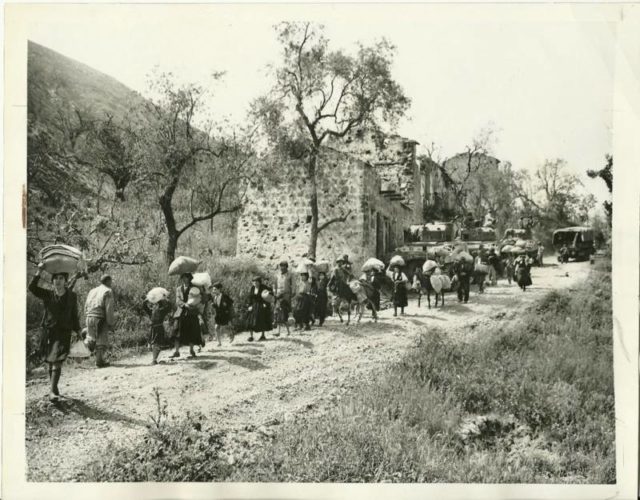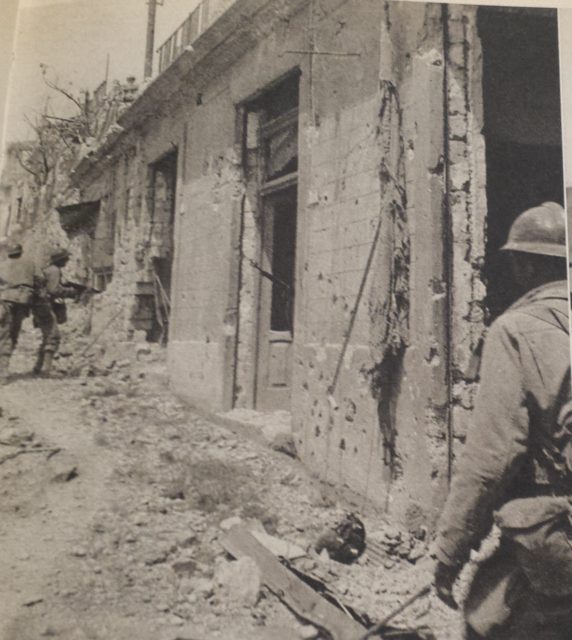War History Online presents the third part of this Guest Article from Pietro Giovanni Liuzzi
Corp Expéditionnaire Français
Anzio – The landing at Anzio took place without difficulty on January 22, 1944. Having conquered the bridgehead, major general John Lucas, instead of pushing the available units to the pre – Apennines, almost 30 Kms away, to cut the retreat of the Germans, he waited for the arrival of the assigned remaining troops. The Germans were caught by surprise but, due to the lack of enemy actions, they managed to display a tank division. Lucas’ decision caused an increase of human losses and a war of attrition prolonged for months. For his strategic error, he was replaced quite soon by general Lucian King Truscott Jr.
Cassino – In May 1944, after nine months of fierce fighting, bombing, shelling and the unnecessary destruction of Montecassino Abbey, the Allied forces launched the 4th “battle of Cassino .“ The Diadem Operation began having the scope to definitely break the Gustav Line and join the Allied troops landed at Anzio and, finally, reach the capital of Italy.
The final assault began at 23.00 hours on May 11, 1944 with artillery preparatory fire, of more than 1,600 guns throwing tons of projectiles on the German positions and the support of more than 3,000 aircraft. Simultaneously, naval shelling pounded the coast from Terracina to Sperlonga along the Thyrrenian Sea.

At 23.45 the 2nd Polish Corps, with two divisions plus the Italian Liberation Corps, launched the attack on Montecassino suffering heavy losses due to the intervention of the 1st German Paratroopers Division.
The British XIII Corps, with great difficulty, was able to cross the Rapido River and continue in the Liri Valley.

Further south moved units of the CEF (Corp Expėditionnaire Français) under the command of General Alphonse Juin, having the objective of intervening in the rocky area of Monte Maio to open the way to Esperia town. Prior to the attack, General Juin offered as a reward for victory to his soldiers 50 hours freedom to act as they wanted: everything would be allowed; no punishment for their actions.
The 88th and 85th American Division launched the attack on the western side. The movement was slow and many losses were counted. The German resistance was tough because they were perched dramatically on the high ground.
The breaking of the Gustav Line was due principally to the French colonial troops in the direction of the Aurunci mountains. The result was unexpected. The French carried out violent assaults due to the peculiarities of the Moroccans, masters in fighting in inaccessible areas. Slaughtering whoever was in their path, they aimed for Castelforte, Ausonia, Esperia where the German services were deployed.

The breach in the Gustav Line between Monte Feuci and Monte Maio was open. The way to Castelforte, Spigno Saturnia, Ausonia, Esperia, forced the Germans to retreat to the north. The battle around Castelforte, a German strongpoint, was fierce and to the death. No more chance to resist once lost.
To the Corp Expéditionnaire Français goes the merit of the breakthrough of the Gustav Line which took place on May 15, 1944. With this action the French intended to prove their ability, to recover the prestige of France after the dishonorable capitulation of 1940 due to the collaboration of the Vichy Republic with the Germans and to counterbalance the coldness of their welcome of the Americans and British upon landing in Algeria in 1942.
For months the Allies tried to advance beyond the Gustav line but they found tremendous difficulties. They suffered a wearying and bloody war of position. In three battles they lost more than 60,000 men. They could not earn a meter; their big vehicles could not move in the rocky terrain. The intervention of the Moroccan, the Goumiers, paved the way with knives fighting hand to hand.

What they did afterward to the population was terrific. They raped and tortured women, old people and children. Those who refused were buried alive or impaled. The parents were forced to watch the raping of their daughters. Even their commanders were unable to stop those wild beasts. General Juin stained the French with infamy for the trail of terror that those barbarians have left in their wake: they ravaged, robbed, pillaged, killed, raped.
The Goumiers, mountaineers of Morocco wearing tribal clothing: a barracan (blanket) with stripes, covering tight pants to the ankle and the high-necked sweaters, on their heads, they wore a wool turban, the Jellaba. They had mules to carry all their paraphernalia and goats, lambs, live sheep to slaughter and baked when needed. Fought at night; climbed noiselessly, silently hit the Germans with knives and short sabers. They began the attack from Monte Faiti on May 11 and on the 14th had reached Castelforte, Coreno, Ausonia, Castelnuovo Parano. They pursued the Germans, now on the run, and their fury broke over Vallecorsa, Pico, Castro Dei Volsci and many other smaller towns, in a long trail of sorrow and shame.
The ultimate goal was Pontecorvo and Casilina road to bypass the positions of the defenders of Monte Cassino. The Germans were forced to retreat.

For such a tremendous and prolonged carnage “the marochinate“ the responsibility must not be laid only with General Juin. De Gaulle was in the area and knew what was going on and he did nothing to stop the barbarity.
Then the Italian Minister Ivanoe Bonomi did not intervene with the Allied commanders. The only one to spend words to stop such brutality was the Pope. Nobody had an interest in stopping those beasts. The Commander’s aim was to overcome the impasse of the Gustav Line and they got it. No matter how. General De Gaulle, at last, gave an order for the arrival of 150 prostitutes in the area from Morocco. 15 Goumiers were shot and 54 sentenced to hard labor for their extraordinary evil.
All the named towns have been awarded the Gold Medal. It is a story nobody wants to talk about for fear to diminish the significance of the liberation by the Allies.
The French remember the battle of Cassino having named Pont du Garigliano a bridge on the Sein in Paris. An Italian survivor says: “ Words are not enough to express the anger and the shame of belonging to the same human race as those who, as winners, were allowed to act with the ferocity of wild animals in committing absurd acts. The German harassment of the district population can be defined as minor compared to what, those in command of the unit Goumiers, French officers, allowed “.
The author, at the age of 9, was in Castelnuovo Parano with his family when, in October 1943, the German SS raked the villagers to transfer in an internment camp in the south of Rome allowing freedom of movement to the troops along the Gustav Line. Many inhabitants managed to escape the raid but, most of them, later, were subject to the marocchinate. The criminal Goumiers’ actions are told in an Alberto Moravia’s novel and in a Vittorio de Sica’s film “La Ciociara (Two Women).”
Pietro Giovanni Liuzzi, essayist
Colonel (Rtd.) Italian Army
Check out Pietro’s Facebook page.
Photos provided by the author.
